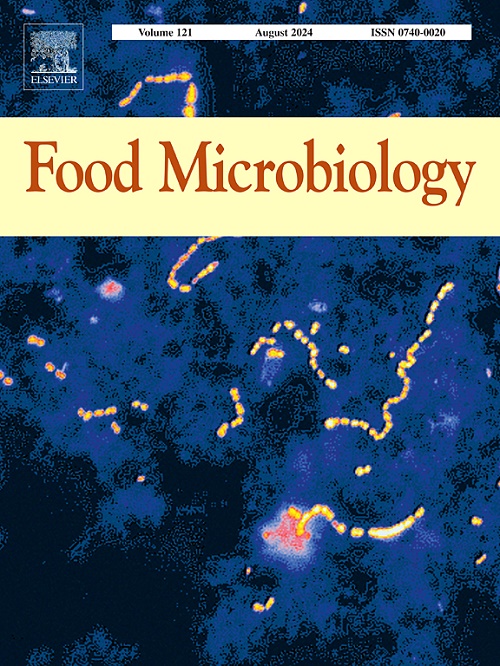Multi-laboratory validation of a modified real-time PCR assay (Mit1C) for the detection of Cyclospora cayetanensis in fresh produce
IF 4.5
1区 农林科学
Q1 BIOTECHNOLOGY & APPLIED MICROBIOLOGY
引用次数: 0
Abstract
Cyclospora cayetanensis is a foodborne protozoan parasite that causes the human diarrheal disease cyclosporiasis. Recently, the US FDA developed a modified real-time PCR method based on a specific mitochondrial target gene (Mit1C) to detect C. cayetanensis in fresh produce. The method was validated by single laboratory validation (SLV) studies in Romaine lettuce, cilantro, and raspberries. The present study aimed to evaluate the performance of the new real-time Mit1C (Mit1C qPCR) method by comparing it with the current BAM Chapter 19b qPCR (18S qPCR) as the reference method for the detection of the protozoan parasite C. cayetanensis in fresh produce in a multi-laboratory validation (MLV) setting with the participation of 13 collaborating laboratories. Each laboratory analyzed twenty-four blind-coded Romaine lettuce DNA test samples that included: two unseeded samples, three samples seeded with five oocysts, and one sample seeded with 200 oocysts in the first round and five unseeded samples, eight samples seeded with five oocysts, and five samples seeded with 200 oocysts in the second round. The overall detection rates across laboratories for Romaine lettuce samples inoculated with 200 and 5 oocysts and un-inoculated samples were 100% (78/78), 69.23% (99/143), and 1.1% (1/91), respectively, for Mit1C qPCR, and 100% (78/78), 61.54% (88/143) and 0% (0/91), respectively, for 18S qPCR. The relative level of detection (RLOD = LOD50, Mit1C/LOD50, 18S) was 0.81 with a 95% confidence interval (0.600, 1.095), which included 1. Thus, Mit1C qPCR and 18S qPCR had statistically similar levels of detection. Mit1C qPCR was highly reproducible as the between-laboratory variance in the test results was nearly zero (0) and showed a high specificity at 98.9%. In conclusion, this study demonstrated that the new, more specific Mit1C qPCR method is an effective alternative analytical tool for detection of C. cayetanensis in fresh produce.
改进的实时荧光定量PCR (Mit1C)检测新鲜农产品中卡耶坦环孢子虫的多实验室验证
卡耶坦环孢子虫是一种引起人类腹泻疾病环孢子虫病的食源性原生动物寄生虫。最近,美国FDA开发了一种基于特定线粒体靶基因(Mit1C)的改进实时PCR方法来检测新鲜农产品中的C. cayetanensis。该方法在长叶莴苣、香菜和覆盆子中进行了单实验室验证(SLV)。本研究旨在通过与现有的BAM Chapter 19b qPCR (18S qPCR)作为参考方法,在13个合作实验室的多实验室验证(MLV)环境下,评估新的实时Mit1C (Mit1C qPCR)方法的性能,并将其与现有的BAM Chapter 19b qPCR (18S qPCR)进行比较,作为检测新鲜农产品中原生动物寄生虫C. cayetanensis的参考方法。每个实验室分析了24个盲编码的长叶莴苣DNA测试样本,包括:2个未播种样本,3个播种5个卵囊样本,1个第一轮播种200个卵囊样本,5个未播种样本,8个播种5个卵囊样本,5个播种200个卵囊样本。接种200个卵囊和5个卵囊的长叶莴苣和未接种的长叶莴苣,Mit1C qPCR的总检出率分别为100%(78/78)、69.23%(99/143)和1.1% (1/91),18S qPCR的总检出率分别为100%(78/78)、61.54%(88/143)和0%(0/91)。相对检测水平(RLOD = LOD50, Mit1C/LOD50, 18S)为0.81,95%可信区间(0.600,1.095)。因此,Mit1C qPCR和18S qPCR的检测水平在统计学上是相似的。由于检测结果的实验室间方差几乎为零(0),Mit1C qPCR具有高度的重复性,并且具有98.9%的高特异性。总之,本研究表明,新的更具特异性的Mit1C qPCR方法是检测新鲜农产品中卡叶青霉的有效替代分析工具。
本文章由计算机程序翻译,如有差异,请以英文原文为准。
求助全文
约1分钟内获得全文
求助全文
来源期刊

Food microbiology
工程技术-生物工程与应用微生物
CiteScore
11.30
自引率
3.80%
发文量
179
审稿时长
44 days
期刊介绍:
Food Microbiology publishes original research articles, short communications, review papers, letters, news items and book reviews dealing with all aspects of the microbiology of foods. The editors aim to publish manuscripts of the highest quality which are both relevant and applicable to the broad field covered by the journal. Studies must be novel, have a clear connection to food microbiology, and be of general interest to the international community of food microbiologists. The editors make every effort to ensure rapid and fair reviews, resulting in timely publication of accepted manuscripts.
 求助内容:
求助内容: 应助结果提醒方式:
应助结果提醒方式:


